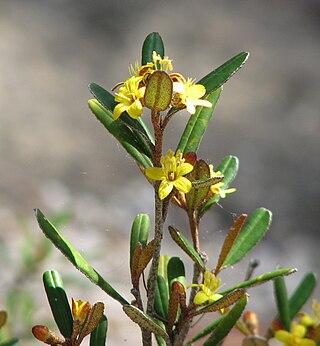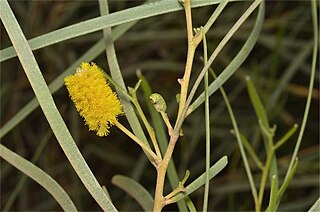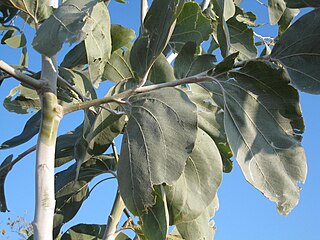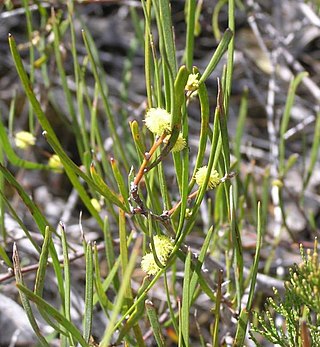
Acacia aneura, commonly known as mulga, is a species of flowering plant in the family Fabaceae and is endemic to inland Australia. It is a variable shrub or small tree with flat, narrowly linear to elliptic phyllodes, cylindrical spikes of bright yellow flowers and more or less flat and straight, leathery pods.

Acacia pycnantha, most commonly known as the golden wattle, is a tree of the family Fabaceae. It grows to a height of 8 metres and has phyllodes instead of true leaves. The profuse fragrant, golden flowers appear in late winter and spring, followed by long seed pods. Explorer Thomas Mitchell collected the type specimen, from which George Bentham wrote the species description in 1842. The species is native to southeastern Australia as an understorey plant in eucalyptus forest. Plants are cross-pollinated by several species of honeyeater and thornbill, which visit nectaries on the phyllodes and brush against flowers, transferring pollen between them.

Acacia decurrens, commonly known as black wattle or early green wattle, is a perennial tree or shrub native to eastern New South Wales, including Sydney, the Greater Blue Mountains Area, the Hunter Region, and southwest to the Australian Capital Territory. It grows to a height of 2–15 m (7–50 ft) and it flowers from July to September.

Acacia penninervis, commonly known as mountain hickory wattle, or blackwood, is a perennial shrub or tree is an Acacia belonging to subgenus Phyllodineae, that is native to eastern Australia.

Acacia pendula, commonly known as the weeping myall, true myall, myall, silver-leaf boree, boree, and nilyah, is a species of wattle, which is native to Australia. The 1889 book The Useful Native Plants of Australia records that common names included "Weeping Myall", "True Myall", and Indigenous people of western areas of New South Wales and Queensland referred to the plant as "Boree" and "Balaar".

Phebalium whitei is a small shrub that is endemic to south-east Queensland. It has branchlets covered with silvery and rust-coloured scales, leathery, oblong to elliptic leaves and bright yellow flowers arranged in sessile umbels on the ends of branchlets.

William Faris Blakely was an Australian botanist and collector. From 1913 to 1940 he worked in the National Herbarium of New South Wales, working with Joseph Maiden on Eucalyptus. Maiden named a red gum in his honour, Eucalyptus blakelyi. His botanical work centred particularly on Acacias, Loranthaceae and Eucalypts.

Acacia cana, or commonly named as boree or the cabbage-tree wattle or broad-leaved nealie, is part of the family Fabaceae and sub-family Mimosoideae. It is a dense shrub- tree that can grow to 6 metres (20 ft) high and is a perennial plant meaning it has long life span and doesn’t necessary produce a high amount of seed. The cabbage-tree wattle heavily flowers from August till October and relies on animals and insects for pollination and dispersal of seeds. This least concern acacia species is found in the western plains of New South Wales and Central Queensland the habitats of these areas are found to be sandy soils and gibber plains.

Acacia adsurgens, commonly known as whipstick wattle or sugar brother, is a species of flowering plant in the family Fabaceae and is endemic to northern areas of Australia. It is a spreading shrub with many stems, flat, linear phyllodes, densely-flowered spikes of yellow flowers, and linear, paper-like or crusty pods.

Acacia angusta is a species of flowering plant in the family Fabaceae and is endemic to Queensland. It is a tree or shrub with thin, linear phyllodes, spherical heads of 12 to 20 flowers, and linear, thinly papery pods up to about 140 mm (5.5 in) long.

Acacia dunnii, commonly known as elephant ear wattle or Dunn's wattle, is a shrub or tree of the genus Acacia and the subgenus Plurinerves.

Eucalyptus whitei, commonly known as White's ironbark, is a eucalypt that is native to Queensland.

Acacia shirleyi, known colloquially as lancewood, is a species of Acacia native to Queensland and the Northern Territory in Australia. It grows as a tree to 15 metres (49 ft) high, with dark grey or black stringy bark and blue-grey foliage. The yellow flowers appear from March to July. It grows in dry scrub, open forest or mixed savannah woodland. Indigenous people used the wood as fuel and to make hunting spears. Cattle can eat the foliage as fodder.

Acacia granitica commonly known as the granite wattle is a shrub in the family Fabaceae. Endemic to Australia, it occurs on the New England Tableland of New South Wales and southern Queensland. It is a species tolerant of poor drainage, frost and snow.

Acacia bancroftiorum, commonly known as Bancroft's wattle, is a shrub belonging to the genus Acacia and the subgenus Phyllodineae that is native to parts of eastern Australia.

Acacia alleniana is a species of flowering plant in the family Fabaceae and is endemic to northern parts of Australia. It is a spindly, open shrub or tree with slender branchlets, thread-like phyllodes, and yellow flowers arranged in 2 to 6 spherical heads in the axils of phyllodes, and thinly leathery pods up to 150 mm (5.9 in) long.

Acacia jucunda, commonly known as yetman wattle, is a shrub or tree belonging to the genus Acacia and the subgenus Phyllodineae that is endemic to north eastern Australia and is considered to be endangered in New South Wales.

Acacia armitii is a species of flowering plant in the family Fabaceae and is endemic to north-eastern Australia. It has more or less erect, very narrowly elliptic to linear phyllodes, flowers arranged in solitary spikes in axils, and linear pods up to 55 mm (2.2 in) long.
Australian online fauna & flora databases: Both the Commonwealth of Australia and its various states maintain a number of online databases which encompass both native and naturalised fauna and flora. Some are taxonomic. Some are descriptive. Some are both. Some indicate threatened or nuisance species. The list below is incomplete.


















